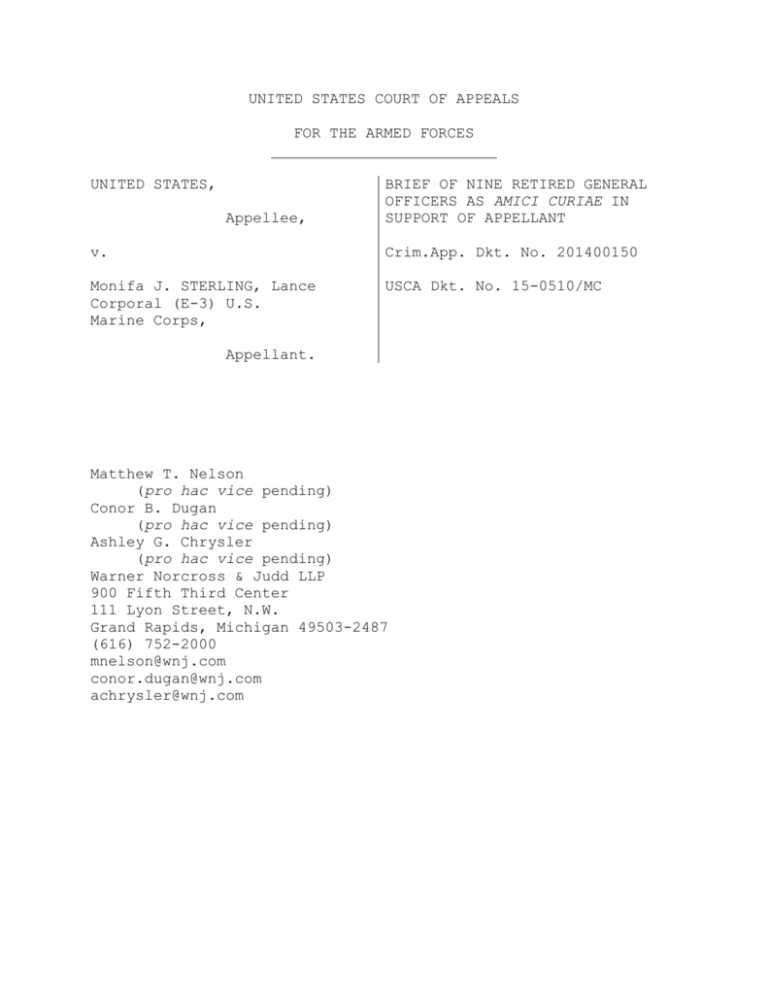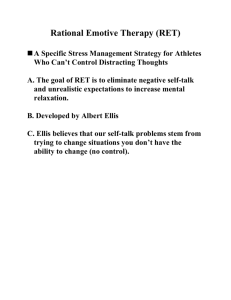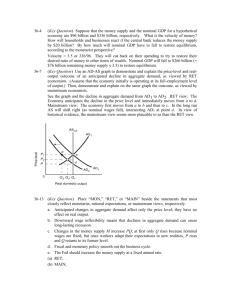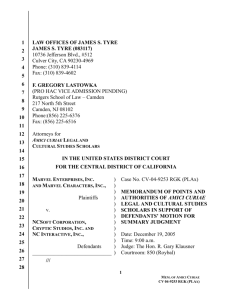UNITED STATES COURT OF APPEALS FOR THE ARMED
advertisement

UNITED STATES COURT OF APPEALS FOR THE ARMED FORCES UNITED STATES, Appellee, BRIEF OF NINE RETIRED GENERAL OFFICERS AS AMICI CURIAE IN SUPPORT OF APPELLANT v. Crim.App. Dkt. No. 201400150 Monifa J. STERLING, Lance Corporal (E-3) U.S. Marine Corps, USCA Dkt. No. 15-0510/MC Appellant. Matthew T. Nelson (pro hac vice pending) Conor B. Dugan (pro hac vice pending) Ashley G. Chrysler (pro hac vice pending) Warner Norcross & Judd LLP 900 Fifth Third Center 111 Lyon Street, N.W. Grand Rapids, Michigan 49503-2487 (616) 752-2000 mnelson@wnj.com conor.dugan@wnj.com achrysler@wnj.com LIST OF AMICI PARTIES General (Ret.) Victor E. Renuart Lieutenant General (Ret.) Michael Gould Lieutenant General (Ret.) William G. Boykin Major General (Ret.) Cecil Richardson Major General (Ret.) Gary L. Harrell Major General (Ret.) Jack Catton, Jr. Brigadier General (Ret.) Orwyn Sampson Brigadier General (Ret.) Richard Abel Brigadier General (Ret.) Gary M. Jones i TABLE OF CONTENTS Page TABLE OF CASES, STATUTES, AND OTHER AUTHORITIES.............. iii INTEREST OF THE AMICI CURIAE................................... 1 SUMMARY OF ARGUMENT............................................ 4 ARGUMENT....................................................... 5 I. The NMCCA’S decision will undermine recruiting and retention of service members and weaken the mission of the armed services.........................5 A. Religion is frequently a motivating factor to join and persevere in the armed services......5 B. The NMCCA’s decision is unworkable in practice and will undermine the military’s mission.........................................11 II. Military men and women who swear to uphold the Constitution should also be afforded its protections..........................................15 CONCLUSION.................................................... 17 ii TABLE OF CASES, STATUTES, AND OTHER AUTHORITIES Page(s) Cases Burwell v. Hobby Lobby Stores, Inc., 134 S. Ct. 2751 (2014) ....................................... 5 Cantwell v. Connecticut, 310 U.S. 296 (1940) ......................................... 15 Church of the Lukumi Babalu Aye, Inc. v. City of Hialeah, 508 U.S. 520 (1993) ......................................... 15 EEOC v. Abercrombie & Fitch Stores, Inc., 135 S. Ct. 2028 (2015) ...................................... 14 Grutter v. Bollinger, 539 U.S. 306 (2003) ......................................... 10 United States v. Sterling, 2015 WL 832587 (N-M. Ct. Crim. App. Feb. 26, 2015) .......... 11 Wisconsin v. Yoder, 406 U.S. 205 (1972) ......................................... 15 Statutes 10 U.S.C. § 502............................................... 16 42 U.S.C. § 2000bb........................................ 13, 14 5 U.S.C. § 3331............................................... 16 Other Authorities Albert L. Smith, Coping with Death and Grief: A Strategy for Army Leadership (2009) (Strategy Research Project, U.S. Army War College) ........... 9 America’s Changing Religious Landscape, Pew. Res. Ctr. 4 (May 12, 2015) ............................................... 6 iii Page(s) Amy M. Burdette, Serving God and Country? Religious Involvement and Military Service Among Young Adult Men, 48 J. Sci. Study Religion 794 (2009) ......................... 7 Brian Wansink & Craig S. Wansink, Are There Atheists in Foxholes? Combat Intensity and Religious Behavior, 52 J. Religion & Health 768 (2013) ........................... 7 Declaration of Independence................................... 12 John S. McCain, John McCain, Prisoner of War: A FirstPerson Account, U.S. News & World Rep. (Jan. 28, 2008) ....................... 8 Kiri Walsh et al., Spiritual Beliefs May Affect Outcome of Bereavement: Prospective Study, 324 BMJ 1551 (2002) .......................................... 9 Ray Nothstine, 35th Anniversary of The Passing of the Night, Acton Inst. Power Blog (May 16, 2008) ........................ 8 Religious Diversity in the U.S. Military (Mil. Leadership Diversity Commission, Issue Paper No. 22, 2010) ................................................. 6, 9, 10 Return to Mogadishu, Remembering Black Hawk Down, YouTube (Sept. 12, 2013) ..................................... 8 The Military-Civilian Gap: War and Sacrifice in the Post9/11 Era, Pew Res. Ctr. 3 (Oct. 5, 2011) ............................... 6 iv INTEREST OF THE AMICI CURIAE Amici curiae are retired general officers of the United States Armed Forces. several reasons. They are interested in this case for First, Amici believe religion and spiritual fitness is an important component of military service. Second, Amici took an oath to support and defend the Constitution, and the decision of the U.S. Navy-Marine Corps Court of Criminal Appeals (NMCCA) strikes at the heart of the first fundamental right protected by the Bill of Rights, the protection of religious liberty. Third, Amici believe that the NMCCA’s decision could adversely affect the military’s recruitment and retention of religiously-committed military members and the military’s ability to fulfill its mission. Amici’s judgment stems from decades of experience in the highest positions in our nation’s military leadership. General (Ret.) Victor E. Renuart served in the U.S. Air Force for 39 years. Most recently, he served as the Commander, North American Aerospace Defense Command and U.S. Northern Command, Peterson Air Force Base, Colorado. Before assuming that position, he was the Senior Military Assistant to the Secretary of Defense, Washington, D.C. Lieutenant General (Ret.) Michael Gould served in the U.S. Air Force for 38 years, where he was the 18th Superintendent of 1 the United States Air Force Academy from 2009-2013. Before that, he served in a number of positions, including as Director of Operations and Plans, U.S. Transportation Command, Scott Air Force Base, Illinois (2008-09); Commander, 2nd Air Force (200508); and Air Force aide to the President (1990-92). Lieutenant General (Ret.) William G. Boykin served in the U.S. Army for 36 years, where he served 13 years in the Delta Force and five years as the United States Deputy Undersecretary of Defense for Intelligence. Major General (Ret.) Cecil Richardson served in the U.S. Air Force for 41 years. He served as Russian interpreter and intercept operator for six years before being ordained as a chaplain, where he served as both Deputy Air Force Chief of Chaplains (2004-08) and 16th Chief of Chaplains of the U.S. Air Force (2008-12). Major General (Ret.) Gary L. Harrell served in the U.S. Army for over 34 years. During his career, General Harrell served as Commander, Special Operations Command Central; Security Director, U.S. Central Command; Commander, 1st Special Forces Operational Detachment-Delta (SFOD); Deputy Commander, SFOD; Squadron Commander special operations officer and troop commander, SFOD; and a member of the 82nd Airborne Division. Major General (Ret.) Jack Catton, Jr. served in the U.S. Air Force for over 31 years. A command pilot and instructor, 2 General Catton logged over 2,650 flying hours in single-seat fighter aircraft. He commanded at the squadron, group, and wing level with tours in the CONUS, Europe, and Pacific. In addition to his operational assignments, he served on the Air Staff, NATO Staff, Joint Staff, and as Inspector General of Pacific Air Forces. General Catton’s Air Force career culminated at Air Combat Command as the Director of Requirements, where he was responsible for the definition of operational requirements for the Combat Air Forces, and the oversight of 260 modernization programs. Brigadier General (Ret.) Orwyn Sampson served in the U.S. Air Force for 32 years. He spent 27 of his 32 years of active service at the U.S. Air Force Academy, where he was involved in all four of the "pillar" mission elements: Instructor and Coach in the Department of Athletics; Assistant AOC and Member of the Military Review Committee with the Commandant of Cadets; Professor and Researcher on the Faculty; and Officer Sponsor of the Cadet Fellowship of Christian Athletes in the Moral/Spiritual area. Brigadier General (Ret.) Richard F. Abel served in the U.S. Air Force for 29 years, including as Director of the Admissions Liaisons Office, Air Force Academy (1972-73); Director of Public Affairs, U.S. Pacific Command (1975-78); Special Assistant to the Chairman of the Joint Chiefs of Staff (1978-80); and 3 Director of Public Affairs, Office of the United States Secretary of the Air Force (1980-85). Brigadier General (Ret.) Gary M. Jones served in the U.S. Army for over 28 years, including as Commander of the U.S. Army Special Forces Command; Deputy Director, Central Intelligence Agency Counter-Terrorism Center; and Commander, 3rd Special Forces Group (Airborne). SUMMARY OF ARGUMENT The decision of the NMCCA threatens the military’s ability to recruit and retain the best and most diverse fighting force. Religious belief has inspired and continues to inspire America’s men and women to join military service. It also serves to strengthen and support service members during their service. By clamping down on religious exercise, the NMCCA’s decision erodes one of the great historical strengths of the U.S. Military: the animating religious beliefs of its members. The NMCCA’s decision does more than that however. It also undermines the mission and good order of the military — something the NMCCA claimed to be attempting to protect with its decision. members. Religious belief motivates many of the military’s It strengthens service members in battle. solace when comrades are hurt or killed. It offers By telling service members that their religious beliefs should be kept to 4 themselves, the NMCCA’s decision will harm morale and the ability of service members to focus on their critical duties. Finally, it is incongruous that service members should swear with God’s aid to support and defend the Constitution, but be deprived of basic exercises of religion like displaying a favorite religious text in a personal workspace. The NMCCA’s decision creates just that sort of dissonance. ARGUMENT I. The NMCCA’S decision will undermine recruiting and retention of service members and weaken the mission of the armed services. The decision of the NMCCA will impair the military’s ability to recruit and retain dedicated and talented soldiers, sailors, airmen, and Marines. And it undercuts the mission and morale of religious members of the armed services by subordinating the basic religious freedoms guaranteed by Congress in the Religious Freedom Restoration Act to the court’s pragmatic views of what is and what is not appropriate religious exercise. Contra Burwell v. Hobby Lobby Stores, Inc., 134 S. Ct. 2751, 2778 (2014). A. Religion is frequently a motivating factor to join and persevere in the armed services. The military, like American society in general, is strikingly religious. The Military-Civilian Gap: War and 5 Sacrifice in the Post-9/11 Era, Pew Res. Ctr. 3 (Oct. 5, 2011) (“In their religious affiliation, veterans are roughly comparable to the general population.”); America’s Changing Religious Landscape, Pew. Res. Ctr. 4 (May 12, 2015) (showing that over 76% of Americans are of one faith or another and that over 70% are Christian). According to the Defense Equal Opportunity Management Institute (DEOMI), over 65% of American military members profess some form of Christian faith. Religious Diversity in the U.S. Military 2 (Mil. Leadership Diversity Commission, Issue Paper No. 22, 2010). Nearly 70% of the military’s members are Christian, Jewish, or Muslim, and over 74% of military members profess some form of religion. Thus, the NMCCA’s decision on its face affects a vast majority of the military’s members. Indeed, religion is often one of the deepest motivations for serving in the military. For some it serves as the impetus or a key impetus to serve the United States. Amici can recount numerous stories of men and women who were motivated to join the military precisely because of their deep religious beliefs. And Amici have no reason to believe their experience is unique. Empirical research supports this. A recent study that examined data from the National Longitudinal Study of Adolescent Health concluded there are “several notable and robust associations 6 between religious identity and military enlistment.” Amy M. Burdette, Serving God and Country? Religious Involvement and Military Service Among Young Adult Men, 48 J. Sci. Study Religion 794, 803 (2009).1 But religion does not simply motivate young men and women to join the military. It also often provides great support and solace during the difficult times that military service brings. Intensity of military involvement often fosters a greater need for the ability to exercise and express one’s religious beliefs. Recent studies indicate that a combat veteran’s reliance on prayer and religion increases as combat intensifies or as negative experiences in the military rise. See Brian Wansink & Craig S. Wansink, Are There Atheists in Foxholes? Combat Intensity and Religious Behavior, 52 J. Religion & Health 768, 771, 773 (2013). Thus, the desire to express or live out one’s religious beliefs, which initially spurs the decision of a soldier, sailor, airman, or Marine to join the military, often grows and intensifies as military service continues. A few specific examples illustrate this. For instance, Jeffrey Struecker was one of the Army Rangers who fought in the firefight memorialized in the movie, Black Hawk Down. 1 He Further, the study found that “[t]hose who are ‘nonreligious’ consistently exhibit lower odds of enlistment in comparison to their ‘highly religious evangelical’ counterparts.” Id. at 802. 7 credits his faith in God with his ability to return to the firefight to check on the status of the downed helicopter. See Return to Mogadishu, Remembering Black Hawk Down, YouTube (Sept. 12, 2013), https://www.youtube.com/watch?v=bTfMpqOXANE. Rear Admiral Jeremiah Denton and Brigadier General James Robison “Robbie” Risner both endured long captivity and torture at the infamous Hanoi Hilton. They too credited their ability to survive the harsh conditions and torture to their faith in God. Ray Nothstine, 35th Anniversary of The Passing of the Night, Acton Inst. Power Blog (May 16, 2008), http://blog.acton.org/archives/2335-35th-anniversary-of-thepassing-of-the-night.html. John McCain also found comfort in prayer and religion while he spent over five years in captivity as a prisoner of war in Hanoi Hilton. He found that “prayer helped” and because of religion, he was “sustained in many times of trial.” John S. McCain, John McCain, Prisoner of War: A First-Person Account, U.S. News & World Rep. (Jan. 28, 2008), http://www.usnews.com/news/articles/2008/01/28/john-mccainprisoner-of-war-a-first-person-account?page=5. Religion also offers service members solace when a fellow service member dies, whether in peacetime or wartime. It is axiomatic that religious beliefs aid persons through the grieving process. One study demonstrated that those “profess[ing] stronger spiritual beliefs . . . resolve[d] their 8 grief more rapidly and completely after the death of a close person than” those without any belief. Kiri Walsh et al., Spiritual Beliefs May Affect Outcome of Bereavement: Prospective Study, 324 BMJ 1551, 1551 (2002). the armed forces. This is no less the case in Indeed, a publication of the United States Army War College, “Coping with Death and Grief: A Strategy for Army Leadership,” describes the important role religion can play in helping service members with grief. “Chaplains are . . . additional force multipliers for commanders, and they can aid in Albert L. Smith, Coping with the maintenance of unit morale.” Death and Grief: A Strategy for Army Leadership 19 (2009) (Strategy Research Project, U.S. Army War College), available at http://www.dtic.mil/dtic/tr/fulltext/u2/a361181.pdf. Chaplains “can help commanders to provide a positive atmosphere and environment for soldiers to deal with death, dying and grief reactions.” Id. at 20. Prohibiting religious expression in the military will also affect the ability of the military to recruit a diverse corps of service members. Over 70% of male African-American service members say that religion is important or very important in their lives. Religious Diversity in the U.S. Military 4 (Mil. Leadership Diversity Commission, Issue Paper No. 22, 2010). percentage is nearly 83% for female African-American service members; indeed, over 60% of female African-American service 9 The members state that religion is very important in their lives. Id. There are similar statistics for Asian-American and Hispanic service members. Nearly 65% of female Asian service members say that religion is important or very important in their lives. Id. Over 54% of male Asian-American service members place a similar value on religion. Id. Among Hispanic service members over 52% of males and over 58% of females say that religion is important or very important in their lives. Id. The NMCCA’s decision sends the wrong message to minority groups for whom faith is important, and could result in diminishing the military’s efforts to recruit qualified minority service members. See Brief for Lt. Gen. Julius W. Becton, Jr. et al. as Amici Curiae Supporting Respondents, Grutter v. Bollinger, 539 U.S. 306 (2003) (No. 02-241); see also Grutter v. Bollinger, 539 U.S. 306, 331 (2003) (citing the general officers’ amicus brief in the Court’s opinion). Thus, the NMCCA decision undermines one of the greatest strengths of America’s military: the religiosity of its members. It effectively tells service members to keep their religious beliefs hidden or face discipline. Service members may believe what they want, but when they choose to act out those beliefs, they may be ostracized, disciplined, or criminally prosecuted. This will harm efforts to recruit and retain the best, brightest, and most diverse military possible. 10 B. The NMCCA’s decision is unworkable in practice and will undermine the military’s mission. The NMCCA claimed to be “sensitive to [] possible implication[s]” on service members’ “Free Exercise and Free Speech rights,” but the sweeping nature of the decision belies this contention. United States v. Sterling, No. 201400150, 2015 WL 832587, slip op. at 10 n.19 (N-M. Ct. Crim. App. Feb. 26, 2015). The NMCCA acknowledged that Lance Corporal Sterling “taped a biblical quotation in three places around her workstation . . . to ‘represent the trinity.’” Id. at 9. Yet, somehow, the court denied there was any evidence that the posting of the signs “was an ‘exercise’” of religion. Id. The NMCCA found that the “record supports the conclusion that the appellant was simply placing . . . personal reminders” for herself on her workstation. Id. The NMCCA considered it significant that Lance Corporal Sterling did not tell her staff sergeant that the “the signs had a religious connotation and never requested any religious accommodation.” Id. The NMCCA also speculated that allowing Lance Corporal’s Sterling’s religious expression would have a “divisive impact to good order and discipline” because other Marines might be exposed to the biblical quotations. Id. at 10. The NMCCA stated that the “risk that such exposure could impact the morale or discipline of the command is not slight.” 11 Id. The NMCCA’s rationale fails. As an initial matter, it is not clear how the NMCCA’s decision would be workable in practice. Service members do not turn off their religiosity until they are given permission to exercise or express it. Moreover, given religion’s vital role in motivating our troops both to serve in the first place and to do their duty in the heat of battle, it is not hard to imagine the problematic implications the NMCCA’s ruling will have. It certainly will undermine the ability to recruit religious persons to the military and it may well undermine the military’s mission as service members worry that their deepest-held beliefs will land them in hot water. Lance Corporal Sterling’s religious expression, which resulted in punishment, occurred in the relative safety of a desk job. But the NMCCA’s broad decision would apply equally to a combat zone. The last thing our troops need during the heat of battle is to be worrying about whether their religious expression, like cries out to divine providence, might result in punishment. Cf. Declaration of Independence (“And in support of this Declaration, with a firm reliance on the protection of divine Providence . . .). The threat to good order here comes from the NMCCA’s decision, not from the potential exposure of other service members to a Biblical quotation. Indeed, if being exposed to a Biblical verse is all that is needed to undermine 12 good order and cohesiveness of Marines (all of whom have withstood the rigors of boot camp where they were instructed on the core values of the Marine Corps by chaplains), then our military has graver problems than potential divisiveness. In short, it is risible to suggest that our military men and women, who risk life and limb to support and defend the Constitution, are so fragile that a verse from a religious text like the Koran, the Bible, the Talmud, or the Vedas would shatter the peace and morale of our armed forces. While Lance Corporal Sterling’s brief does an excellent job arguing the legal merits of her case, two issues bear mentioning. First, the foregoing should make clear that the Marines had no compelling governmental interest under the Religious Freedom Restoration Act (“RFRA”), 42 U.S.C. §§ 2000bb et seq, to place a substantial burden on Sterling’s exercise of religion. Indeed the military, in order to foster good order and discipline, has a compelling interest in allowing the freest expression of religion possible. Such free expression will allow the military to flourish and achieve its critical mission. Second, Lance Corporal Sterling did not have an obligation to tell her superiors about her religious beliefs to allow them the opportunity to “accommodate” them. One does not need to opt-in to protect a Constitutional right; nor is there anything in RFRA’s text or structure that would suggest that RFRA’s 13 protection only applies where one has asked for an accommodation. RFRA commands that the government “shall not substantially burden a person’s exercise of religion . . . except as provided.” 42 U.S.C. § 2000bb-1(a). The only justification for such a burden is where the government “demonstrates that application of the burden” is in “furtherance of a compelling governmental interest” and where “it is the least restrictive means” of furthering that interest. § 2000bb-1(b). 42 U.S.C. The government cannot be relieved of its duty by showing that it was not asked to accommodate a religious practice.2 In short, allowing military members to express their religious beliefs will not adversely affect performance in the military. To the contrary, because religion is an integral part of military life and a motivating factor for many service members’ decisions to join the military, allowing such expression will enhance mission readiness. Accordingly, this Court should reverse the NMCCA’s decision. 2 In a related context, the Supreme Court recently explained that a person does not need to specifically request a religious accommodation to put a potential employer on notice that the person’s appearance or conduct is motivated by the person’s religious beliefs. See EEOC v. Abercrombie & Fitch Stores, Inc., 135 S. Ct. 2028, 2032-33 (2015). 14 II. Military men and women who swear to uphold the Constitution should also be afforded its protections. Religious liberty is often described as our “first right.” The Founders agreed. They placed the freedom of religious exercise in the first clause of the First Amendment for a reason. Indeed, the Supreme Court has made clear time and time again that religious freedom and expression is a core right protected by the Constitution. See Wisconsin v. Yoder, 406 U.S. 205, 214 (1972) (describing the “the right to free exercise of religious beliefs” as a “fundamental right”); Cantwell v. Connecticut, 310 U.S. 296, 303 (1940). Further, “the First Amendment forbids an official purpose to disapprove of a particular religion or of religion in general.” Church of the Lukumi Babalu Aye, Inc. v. City of Hialeah, 508 U.S. 520, 532 (1993). Enlistees and officers are required to take an oath to “support and defend the Constitution” and invoke God’s aid to fulfill their oath. For instance, the oath for enlistees states: I, __________, do solemnly swear (or affirm) that I will support and defend the Constitution of the United States against all enemies, foreign and domestic; that I will bear true faith and allegiance to the same; and that I will obey the orders of the President of the United States and the orders of the officers appointed over me, according to regulations and the Uniform 15 Code of Military Justice. So help me God. [10 U.S.C. § 502(emphasis added).] Officers swear a similar oath. See 5 U.S.C. § 3331.3 Because service members—whether enlisted or officers—swear an oath to uphold the Constitution, this is all the more reason to protect and foster their right to religious expression. The NMCCA’s decision is exactly the sort of decision disapproving of religion that is prohibited by the Constitution. To allow the NMCCA’s decision to stand is to require service members to defend the Constitution without enjoying any meaningful access to a fundamental right guaranteed by the Constitution. It is extremely contradictory to require military men and women to vow to defend the freedom of religious expression while simultaneously prohibiting them from exercising that very right they swear to defend. It is all the more problematic to prevent a military member from exercising his or her own religious beliefs when the oath he or she is required to take to join the 3 The officer’s oath reads in full: I, AB, do solemnly swear (or affirm) that I will support and defend the Constitution of the United States against all enemies, foreign and domestic; that I will bear true faith and allegiance to the same; that I take this obligation freely, without any mental reservation or purpose of evasion; and that I will well and faithfully discharge the duties of the office on which I am about to enter. So help me God.” 16 military invokes God’s very aid. This is all the more reason to reverse the NMCCA’s decision. CONCLUSION For these reasons, this Court should reverse the NMCCA’s decision. Dated: December 28, 2015 /s/ Conor B. Dugan Matthew T. Nelson Conor B. Dugan Ashley G. Chrysler Warner Norcross & Judd LLP 900 Fifth Third Center 111 Lyon Street, N.W. Grand Rapids, Michigan 49503-2487 (616) 752-2000 mnelson@wnj.com conor.dugan@wnj.com achrysler@wnj.com Attorneys for Amici Curiae 17 CERTIFICATE OF FILING AND SERVICE I certify that a copy of the foregoing was electronically delivered to this Court, and that copies were electronically delivered to: Michael D. Berry (mberry@libertyinstitute.org), Paul Clement (pclement@bancroftpllc.com), George Hicks (ghicks @bancroftpllc.com), and John J. Stephens (john.j.stephens@navy. mil), attorneys for Lance Corporal Sterling; Director, Appellate Government Division (brian.k.keller @navy.mil, mark.jamison @navy.mil); Director, Administrative Support Division, NavyMarine Corps Appellate Review Activity (james.n.duncan@navy. mil); Mithun Mansinghani (Mithun.Mansinghani@oag.ok.gov), attorney for amicus curiae State of Oklahoma; and Daniel Blomberg (dblomberg@becketfund.org), attorney for amicus curiae Aleph Institute, et al., on December 28, 2015. Dated: December 28, 2015 /s/ Conor B. Dugan Matthew T. Nelson Conor B. Dugan Ashley G. Chrysler Warner Norcross & Judd LLP 900 Fifth Third Center 111 Lyon Street, N.W. Grand Rapids, Michigan 49503-2487 (616) 752-2000 mnelson@wnj.com conor.dugan@wnj.com achrysler@wnj.com Attorneys for Amici Curiae CERTIFICATE OF COMPLIANCE 1. This brief complies with the type-volume limitation of Rule 24(c) because it does not exceed 7,000 words. 2. This brief complies with the typeface and type style requirements of Rule 37 because it has been prepared in a monospaced typeface using Microsoft Word 2010 with Courier New, 12-point font, 10 characters per inch. Dated: December 28, 2015 /s/ Conor B. Dugan Matthew T. Nelson Conor B. Dugan Ashley G. Chrysler Warner Norcross & Judd LLP 900 Fifth Third Center 111 Lyon Street, N.W. Grand Rapids, Michigan 49503-2487 (616) 752-2000 mnelson@wnj.com conor.dugan@wnj.com achrysler@wnj.com Attorneys for Amici Curiae









